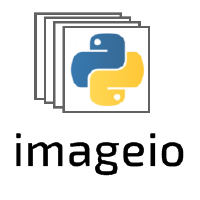imageio.plugins.pillow_legacy#
Read/Write images using pillow/PIL (legacy).
Backend Library: Pillow
Pillow is a friendly fork of PIL (Python Image Library) and supports reading and writing of common formats (jpg, png, gif, tiff, …). While these docs provide an overview of some of its features, pillow is constantly improving. Hence, the complete list of features can be found in pillows official docs (see the Backend Library link).
Parameters for Reading#
- pilmodestr
(Available for all formats except GIF-PIL) From the Pillow documentation:
‘L’ (8-bit pixels, grayscale)
‘P’ (8-bit pixels, mapped to any other mode using a color palette)
‘RGB’ (3x8-bit pixels, true color)
‘RGBA’ (4x8-bit pixels, true color with transparency mask)
‘CMYK’ (4x8-bit pixels, color separation)
‘YCbCr’ (3x8-bit pixels, color video format)
‘I’ (32-bit signed integer pixels)
‘F’ (32-bit floating point pixels)
PIL also provides limited support for a few special modes, including ‘LA’ (‘L’ with alpha), ‘RGBX’ (true color with padding) and ‘RGBa’ (true color with premultiplied alpha).
When translating a color image to grayscale (mode ‘L’, ‘I’ or ‘F’), the library uses the ITU-R 601-2 luma transform:
L = R * 299/1000 + G * 587/1000 + B * 114/1000
- as_graybool
(Available for all formats except GIF-PIL) If True, the image is converted using mode ‘F’. When mode is not None and as_gray is True, the image is first converted according to mode, and the result is then “flattened” using mode ‘F’.
- ignoregammabool
(Only available in PNG-PIL) Avoid gamma correction. Default True.
- exifrotatebool
(Only available in JPEG-PIL) Automatically rotate the image according to exif flag. Default True.
Parameters for saving#
- optimizebool
(Only available in PNG-PIL) If present and true, instructs the PNG writer to make the output file as small as possible. This includes extra processing in order to find optimal encoder settings.
- transparency:
(Only available in PNG-PIL) This option controls what color image to mark as transparent.
- dpi: tuple of two scalars
(Only available in PNG-PIL) The desired dpi in each direction.
- pnginfo: PIL.PngImagePlugin.PngInfo
(Only available in PNG-PIL) Object containing text tags.
- compress_level: int
(Only available in PNG-PIL) ZLIB compression level, a number between 0 and 9: 1 gives best speed, 9 gives best compression, 0 gives no compression at all. Default is 9. When
optimizeoption is Truecompress_levelhas no effect (it is set to 9 regardless of a value passed).- compression: int
(Only available in PNG-PIL) Compatibility with the freeimage PNG format. If given, it overrides compress_level.
- icc_profile:
(Only available in PNG-PIL) The ICC Profile to include in the saved file.
- bits (experimental): int
(Only available in PNG-PIL) This option controls how many bits to store. If omitted, the PNG writer uses 8 bits (256 colors).
- quantize:
(Only available in PNG-PIL) Compatibility with the freeimage PNG format. If given, it overrides bits. In this case, given as a number between 1-256.
- dictionary (experimental): dict
(Only available in PNG-PIL) Set the ZLIB encoder dictionary.
- prefer_uint8: bool
(Only available in PNG-PIL) Let the PNG writer truncate uint16 image arrays to uint8 if their values fall within the range [0, 255]. Defaults to true for legacy compatibility, however it is recommended to set this to false to avoid unexpected behavior when saving e.g. weakly saturated images.
- qualityscalar
(Only available in JPEG-PIL) The compression factor of the saved image (1..100), higher numbers result in higher quality but larger file size. Default 75.
- progressivebool
(Only available in JPEG-PIL) Save as a progressive JPEG file (e.g. for images on the web). Default False.
- optimizebool
(Only available in JPEG-PIL) On saving, compute optimal Huffman coding tables (can reduce a few percent of file size). Default False.
- dpituple of int
(Only available in JPEG-PIL) The pixel density,
(x,y).- icc_profileobject
(Only available in JPEG-PIL) If present and true, the image is stored with the provided ICC profile. If this parameter is not provided, the image will be saved with no profile attached.
- exifdict
(Only available in JPEG-PIL) If present, the image will be stored with the provided raw EXIF data.
- subsamplingstr
(Only available in JPEG-PIL) Sets the subsampling for the encoder. See Pillow docs for details.
- qtablesobject
(Only available in JPEG-PIL) Set the qtables for the encoder. See Pillow docs for details.
- quality_modestr
(Only available in JPEG2000-PIL) Either “rates” or “dB” depending on the units you want to use to specify image quality.
- qualityfloat
(Only available in JPEG2000-PIL) Approximate size reduction (if quality mode is rates) or a signal to noise ratio in decibels (if quality mode is dB).
- loopint
(Only available in GIF-PIL) The number of iterations. Default 0 (meaning loop indefinitely).
- duration{float, list}
(Only available in GIF-PIL) The duration (in seconds) of each frame. Either specify one value that is used for all frames, or one value for each frame. Note that in the GIF format the duration/delay is expressed in hundredths of a second, which limits the precision of the duration.
- fpsfloat
(Only available in GIF-PIL) The number of frames per second. If duration is not given, the duration for each frame is set to 1/fps. Default 10.
- palettesizeint
(Only available in GIF-PIL) The number of colors to quantize the image to. Is rounded to the nearest power of two. Default 256.
- subrectanglesbool
(Only available in GIF-PIL) If True, will try and optimize the GIF by storing only the rectangular parts of each frame that change with respect to the previous. Default False.
Notes#
To enable JPEG 2000 support, you need to build and install the OpenJPEG library,
version 2.0.0 or higher, before building the Python Imaging Library. Windows
users can install the OpenJPEG binaries available on the OpenJPEG website, but
must add them to their PATH in order to use PIL (if you fail to do this, you
will get errors about not being able to load the _imaging DLL).
GIF images read with this plugin are always RGBA. The alpha channel is ignored when saving RGB images.
